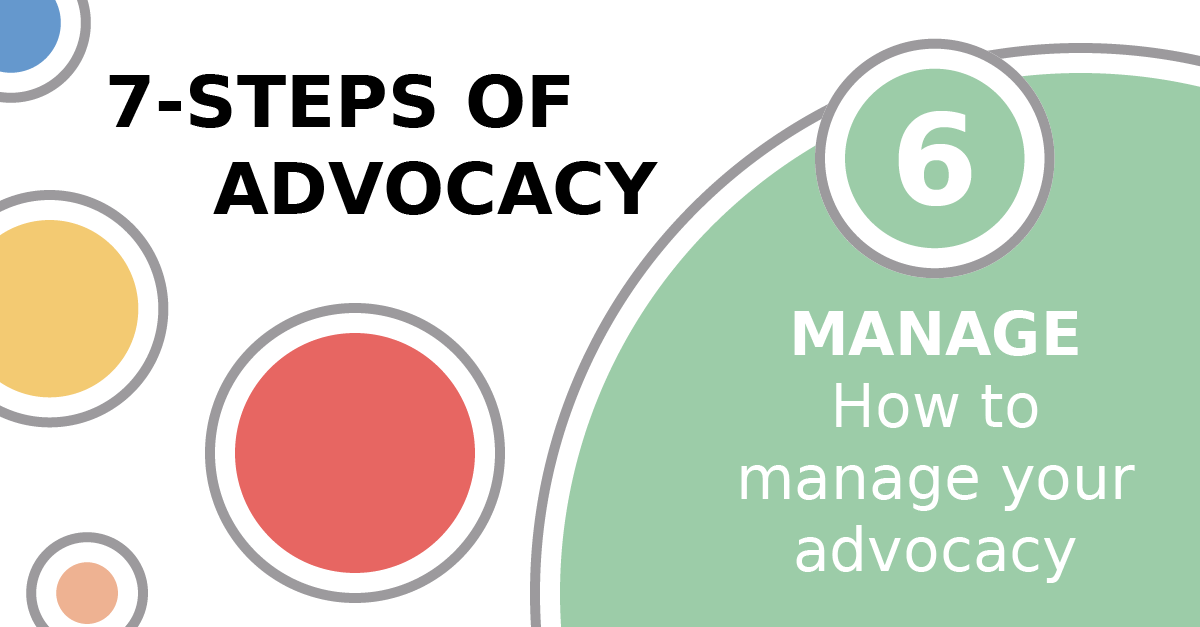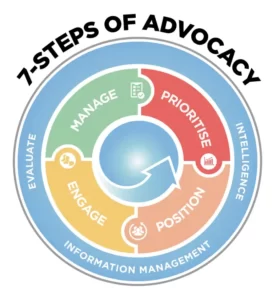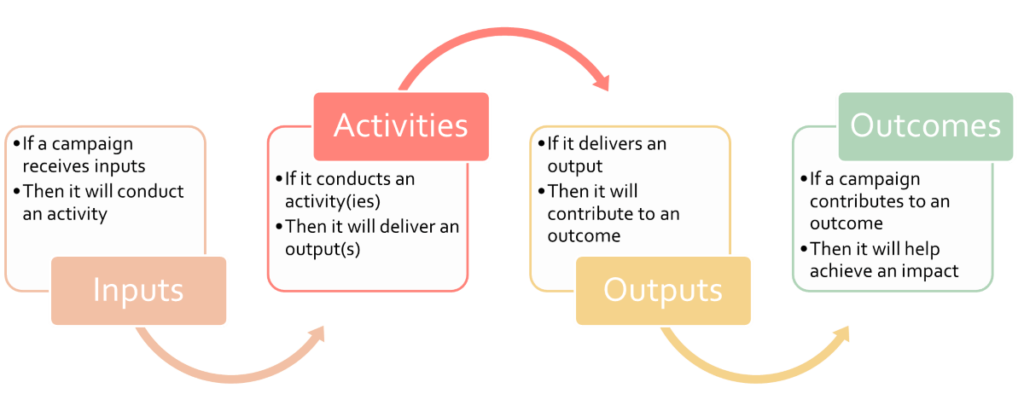
Step 6 of the 7-Step advocacy method concerns Managing.
In a world where we are constantly required to deliver more with less, how you manage is extremely important. Across people, processes, technology and finance clear management is key. Advocacy Strategies must be well structured, and action plans relevant and realistic with built-in feedback channels, evaluation methodology and a corresponding readiness to adapt. Dashboards keep you abreast of progress; they can also be a useful communication tool within the team. Advocacy teams collaborate best where they have clear roles and targets.

Managing advocacy requires planning backwards from your long-term goals to your activities and resources, supported with KPIs and relevant feedback. Budgets need to be linked to activities, and dashboards provide dynamic visualizations of campaigns and progress to identify areas of strength, weakness, success and failure. You need to keep all of this under active management to maintain focus and discipline. You want to ensure that you are always focused on high-impact tasks whilst building the internal buy-in you need to get the job done. A well-managed advocacy campaign gives you the greatest chances of external success and simultaneously builds support and engagement within your organization.
Step 6 pulls together everything from the first 5 steps of the 7-Step advocacy method. These were all about preparation and engagement. To succeed your campaign must manage all of these moving parts because only in this way will you be agile and able to respond to internal and external challenges you will face. How you do this is the focus of this blog post as well our free Advocacy Plan Template and free presentation on Advocacy Strategy Basics with examples of a GANTT chart, Action Plan, campaign and policy timelines and more. As an advocacy professional you will need to answer the question: How do I best manage my advocacy work and what do I need to do that?
Manage, the 6th step of the 7-step advocacy method, is all about finding the right tools to best oversee, follow, present and sell your work. We call this your need to deliver best-in-class Campaign Management, which we will look at now.
Campaign Management
The tools you will need to manage your advocacy work and campaigns are the key to this step. Let us outline some of the main ones you will need to use and adapt to be successful.
Action plan: In its simplest form your campaign needs an action plan. The action plan is a table that focuses on managing your campaign’s engagement activities (Step 5) and building-in your KPIs (Steps 1 and 7). Activities will be listed in chronological order as rows on a table with activities grouped according to the output they contribute towards. Your action plan columns should include information on:
- Phase: The phase of the campaign (i.e. reputation building or parliamentary lobbying) covered by that row in sequential order (see timeline below).
- Action: The activities undertaken to deliver the advocacy output in that phase, in sequential order.
- Duration & Deadline: The timeframe of each activity and the delivery deadline.
- Budget: The allotted budget for the actions in question
- Lead: The team member with primary responsibility for the phase and activities.
- Team: The support staff, both internal and external.
- Approach: The tool(s) to be used, both administrative and/or advocacy.
- Expected outcome: The expected outcome for the phase and its activities with a view to the achievement of the overall objectives and goal. This can include your KPI.
Indicators: As mentioned before, Step 1 covers KPIs and Step 7 of the 7-Step method covers evaluation. These are crucial ingredients for a successful action plan, namely the ability to measure results. An effective action plan needs to provide the team with evidence of results (i.e. evidence of success or failure). By seeing success, you are able to reward it. In rewarding success, you are able to avoid rewarding failure. In recognizing failure, you are able to avoid repeating mistakes. By demonstrating results, you are able to build leadership buy-in and support for your advocacy. Make sure your action plan includes KPI and indicators.
Assumptions: Alongside focusing on results, your action plan must also define the assumptions you make in your campaign and action plan. These assumptions are potential risks. Your action plan must try to critically define and assess the validity of your strategic choices when it comes to advocacy actions, outputs and the change you expect them to result in. What are you assuming when hiring or outsourcing an activity such as graphic design work? What is your assumption for the direct or indirect campaign strategy? Will your stakeholders be reached by your choice of communication media (i.e. social media or print advertisement)? What is your assumption regarding the impact of your advocacy actions upon these key stakeholders? What will they do or not do? Make sure your action plan assesses risks. Causal pathways: Another key ingredient for an effective action plan is the clear definition of causal pathways between key steps of your campaign (i.e. between the resources, the activities, the outputs and the objectives and goals). Thus, in defining your action plan you must critically reflect on the causality that you are predicting to come from your actions. The causal pathway in your campaign can be visualized as follows:

Remember that the further you move from your activities towards your impact (or goal), the harder it is for you to claim a causal relationship between your actions and the policy change.
Theory of Change: Linking the tasks of defining assumptions and mapping the causal pathway for your advocacy work is called the Theory of Change. The Theory of Change is established best practice, particularly in the NGO sector. It is a powerful tool for advocacy campaign management. Theories of Change can be expressed as a narrative text or a diagram. Theory of Change is a tool for communication to others about what you expect to have happened as a result of your campaign. A Theory of Change contains:
- Causal Pathways: Information on how actions will produce change: i.e. causal pathway.
- Assumptions: Information on your risk analysis and assumptions: What external factors need to be true in order for you to succeed.
- Evidence: Evidence to explain why changes should happen as a result of your advocacy campaign. For example scientific, academic or case study evidence on the effectiveness of specific advocacy strategies.
The theory of change is a more flexible approach to managing your campaign than that offered by action plans (see above) or scoreboards (see below). The major innovation in the theory of change is to provide a narrative with evidence, through examples, case studies, empirical research data, which will support your campaign’s assumptions and causal pathway. It will provide the proof you need to support your strategic choices. Proof that can be revised on the basis of feedback.
Scorecard: Your action plan can be used as template for a scorecard (or dashboard) for your campaign (or project). The scoreboard provides at a glance information about performance and it is used to monitor progress towards achieving your goals and objectives. The scorecard can include a timeline of the activities and outputs preferably aligned with the policy process (see Timeline below). The scorecard should have a table with project priorities, objectives, KPI and means of measurement. Notes can be taken by the team concerning prioritization and performance, ensuring teams are motivated through a shared understanding of prioritization and performance.
Timing-Timeline: A successful campaign management framework requires a timeline (such as the GANTT chart below) to ensure tight alignment between the policy-making process and the campaign activities. Key policy-making milestones, both predicted and known, should be placed along this timeline. When will proposals be tabled, debated, voted and adopted? When will a proposal be drafted, impact assessed and stakeholders consulted? Alongside this you should define the advocacy activities that will be implemented (i.e. meeting programmes, field trips, social media campaigns). A timeline will ensure your team have a clear overview of the campaign as a whole, while focusing on those activities most relevant for that specific moment in time. Check out our presentation on Advocacy Strategy Basics with examples of a GANTT chart, Action Plan, campaign and policy timelines and more.

There is no one-size-fits-all approach to managing your advocacy campaign. Identifying the best approach requires careful consideration of your own organization’s project management culture, preferred tools as well as your advocacy team’s capacity to buy-in to the campaign management framework. Check-out our excellent Advocacy Plan Template. This template provides a great framework for planning your advocacy campaign. It ensures your plan includes the key components discussed in this blog and more, notably information on your issue, stakeholders, timeline, theory of change, resources and risks.
This is the 6th blog in the series of our 7-Step Method. In the final blog of the series we’ll be exploring Step 7: Evaluate to clearly define its place in the 7-Step Method and also to identify the key knowledge, skills, tools, and deliverables contained within it. To further explore our 7-steps of advocacy method as well as our free advocacy tools, including our free advocacy assessment 7-step snapshot report, please visit: advocacystrategy.com



